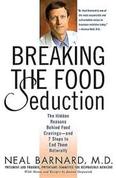
In a July (2013) blog I reported my fascination with Dr. Neal Barnard’s
book, Power Foods for the Brain, and his remarkable research showing that a plant-based diet and intense exercise can reverse the genetic tendency towards dementia and Alzheimer’s Disease that afflict so many.
I’d like to mention another book he’s written, which I feel is even more important than Power Foods. Breaking the Food Seduction, published in 2003, explains why Americans are addicted to so many foods that eventually cause weight gain, obesity, and disease. The book opened my eyes. I recommend it as a core foundation to changing to a LifeNuts lifestyle – and enjoying your old age instead of griping and moaning about your pains, pill, and medical problems.
I’ll give a few highlights. First, American researchers have found that children (many of whom are overweight these days) have the beginnings of artery blockage before finishing high school. Obese adults in their 20s often have high blood pressure – related to this blockage, which becomes the basis of an early heart attack or stroke.
Cheese addiction? Yes, chefs know that Americans love cheese and they put it on all salads (you can request no cheese when you order) and on many dishes. From 1975 to 1999 cheese consumption doubled. Now the average American consumes 33 pounds of it each year. Why, you ask. Opiates. Yes, the same drug found in opium. It’s addicting, right? Yes it is. The milk protein, casein, breaks down when digested into casomorphins, a host of opiates. A cup of cow’s milk contains six grams of casein, skim milk contains more, and cheese is the mother lode of casein. So, it’s not just the taste, texture, or smell of cheese that intoxicates us – it’s the opiate stimulation of dopamine in our brain. That “good mood” feeling, as some food manufacturers and fast food places like to use in their marketing. Yes, cheese lovers are opiate addicts. Sorry to be so blunt, but most are not aware of this. And cheese consumption increases every year.
Meat addiction? Many people who lived in the Great Depression could not afford meat; they were stuck with fruits and vegetables. Few were obese in those dark days. And now, cultures that National Geographic has studied over the past 20 years – you know, the ones where lots of people live into their 90s and 100s – have the same diet, perhaps mainly because they, too, could not afford meat in their early years. Of course, they also “moved” much more than our American couch potatoes who watch an average of five hours of television a day.
Today, most can afford to consume meat daily, even if it’s a Big Mac or a roast beef sandwich, and Americans have come to view a meal as not complete without a meat serving. Why? Meat causes the release of opiates in your brain, which stimulates a strong release of insulin, which in turn triggers the release of dopamine in the brain, which makes us feel good. Good enough to include meat
in every meal. Meat, cheese, and fish all cause this release of insulin. So, once again, Americans unknowingly are addicts. And, as a debt ridden nation, we, our children, and our grandchildren pay the price. Restaurant owners, fast food franchises, and chefs understand that they must satisfy consumers’ cravings and their offerings relate directly to the demand for cheese and meat.
Do you think white meat is better than red meat? Think again. Chicken has nearly as much cholesterol and fat as lean beef. Fish? Anywhere from 15 to 30 percent of fish fat is basically artery-clogging saturated fat.
So why is the American diet filled with so many unhealthy choices? The meat and dairy industries are strong supporters of the American Dietetic Association and the American Medical Association. Very strong. They also lobby extensively in Washington, especially towards the USDA. Despite this lobbying, the government recently changed the menus in low-income area schools to offer only healthy choices. Guess what? The kids turned up their noses. They didn’t like the taste of fruits, pasta, and veggies. So officials brought back the meat and cheese. Nice try, anyway.
That’s why LifeNuts aims to change the culture of a community, be it a town of 500 or 500,000. If a family and, along with it, a community begins to adopt a plant based diet and an intensive exercise programs, the pounds will melt away, health care costs will drop, and people will become more productive since they now have more energy.
What can you do? For starters, read Dr. Barnard’s book to understand your addictions. And then
change. He claims your taste buds will change in about three weeks and you’ll break your opiate addiction. Well, it may take four to six weeks or maybe a bit longer; so don’t be discouraged. The pounds will be shed and you’ll fit into clothes you wore when you were a teenager. Trust me, I know. I’ve lost 50 pounds since I began this journey several years ago and my waist is the same as when I was 25, which was over 40 years ago. A LifeNuts lifestyle is worth it!

 RSS Feed
RSS Feed